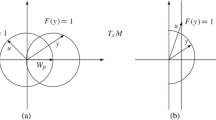Abstract
A prime geodesic theorem is derived for rank-one geodesics in quotients of SL4. This has applications in class number asymptotics for quartic fields. For these applications it is necessary to prove a more general statement than in the literature: several regularity conditions have to be abandoned. As a consequence, the analytical difficulties multiply. The final result is obtained by a sandwiching argument from infinitely many independent asymptotics.
Similar content being viewed by others
References
Borel A. (1969). Introduction aux groupes arithmétiques. Hermann, Paris
Borel, A., Wallach, N.: Continuous Cohomology, Discrete Groups, and Representations of Reductive Groups. Ann. Math. Stud. Vol. 94, Princeton (1980)
Cartan H. and Eilenberg S. (1956). Homological Algebra.. Princeton University Press, Princeton, NJ
Chandrasekharan, K.: Introduction to Analytic Number Theory. Springer-Verlag (1968)
Conway J. (1978). Functions of One Complex Variable. Springer-Verlag, New York
Deitmar A. (1995). Higher torsion zeta functions. Adv. Math. 110: 109–128
Deitmar A. (2000). Geometric zeta-functions of locally symmetric spaces. Am. J. Math. 122(5): 887–926
Deitmar A. (2002). Class numbers of orders in cubic fields. J. Number Theory 95: 150–166
Deitmar A. (2004). A prime geodesic theorem for higher rank spaces. Geom Funct Anal 14: 1238–1266
Deitmar A. and Hoffman J. (2006). The Ihara-Selberg zeta function for PGL3 and Hecke operators. Int. J. Math. 17: 143–156
Deitmar, A.: A prime geodesic theorem for higher rank spaces II: singular geodesics. Rocky Mountain J. Math. (2006)
Deitmar, A., Pavey, M.: Class numbers of orders in complex quartic fields. Mathematische Annalen. (to appear)
Dieudonné, J.: Treatise on Analysis. Academic Press (1976)
Gangolli R. (1977). The length spectrum of some compact manifolds of negative curvature. J. Diff. Geom. 12: 403–426
Gelfand, I.M., Graev, M.I., Pyatetskii-Shapiro, I.I.: Representation Theory and Automorphic Functions. Saunders (1969)
Harish–Chandra J. (1975). Harmonic analysis on real reductive groups I. The theory of the constant term. J. Func. Anal. 19: 104–204
Hecht H. and Schmid W. (1983). Characters, asymptotics and \({\mathfrak{n}}\) -homology of Harish–Chandra modules. Acta Math. 151: 49–151
Hejhal, D.: The Selberg Trace Formula for \(PSL_2({\mathbb{R}})\) I. Springer Lecture Notes 548 (1976)
Hochschild G. and Serre J.-P. (1953). Cohomology of Lie algebras. Ann. Math. 57: 591–603
Hochschild G. and Serre J.-P. (1953). Cohomology of group extensions. Trans. Am. Math. Soc. 74: 110–134
Hopf H. and Samelson H. (1941). Ein Satz über die Wirkungsräume geschlossener Liescher Gruppen. Comment. Math. Helv. 13: 240–251
Howe R. and Moore C. (1979). Asymptotic properties of unitary representations. J. Funct. Anal. 32: 72–96
Juhl A. Cohomological Theory of Dynamical Zeta functions. Progress in Mathematics, Vol. 194. Birkhäuser Verlag, Basel (2001)
Knapp, A.: Representation Theory of Semisimple Lie Groups. Princeton University Press (1986)
Knieper G. (1997). On the asymptotic geometry of nonpositively curved manifolds. Geom. Funct. Anal. 7: 755–782
Koyama S. (1998). Prime geodesic theorem for arithmetic compact surfaces. Internat. Math. Res. Notices 8: 383–388
Labesse J.P. (1991). Pseudo-coefficients très cuspidaux et K-théorie. Math. Ann. 291: 607–616
Luo W. and Sarnak P. (1995). Quantum ergodicity of eigenfunctions on \({PSL}_2(Z)\backslash H^2\) Inst. Hautes ÈTudes Sci. Publ. Math. 81: 207–237
Margulis G.A. (1969). Certain applications of ergodic theory to the investigation of manifolds of negative curvature. Funkcional. Anal. i Priložen. 3(4): 89–90
Pierce R.S. (1982). Associative Algebras. Springer-Verlag, New York
Pollicott M. and Sharp R. (1998). Exponential error terms for growth functions on negatively curved surfaces. Am. J. Math. 120(5): 1019–1042
Randol B. (1977). On the asymptotic distribution of closed geodesics on compact Riemann surfaces. Trans. AMS 233: 241–247
Randol B. (1978). The Riemann hypothesis for Selberg’s zeta-function and the asymptotic behavior of eigenvalues of the Laplace operator. Trans. Am. Math. Soc. 236: 209–223
Sarnak P. (1982). Class numbers of indefinite binary quadratic forms. J. Number Theory 15: 229–247
Selberg, A.: On Discontinuous Groups in Higher-dimensional Symmetric Spaces. 1960 Contributions to function theory (internat. Colloq. Function Theory, Bombay, 1960), pp. 147–164. Tata Institute of Fundamental Research, Bombay.
Selberg A. (1956). Harmonic analysis and discontinuous groups in weakly symmetric Riemannian spaces with applications to Dirichlet series. J. Indian Math. Soc. 20: 47–87
Speh B. (1981). The unitary dual of Gl(3,R) and Gl(4,R). Math. Ann. 258: 113–133
Wallach N. (1976). On the Selberg Trace Formula in the case of compact quotient. Bull. AMS 82(2): 171–195
Witte, D.: Introduction to arithmetic groups. http://arxiv.org/abs/math/0106063.
Wolf J. (1962). Discrete groups, symmetric spaces and global holonomy. Am. J. Math. 84: 527–542
Zelditch S. (1989). Trace formula for compact Γ \ PSL 2(R) and the equidistribution theory of closed geodesics. Duke Math. J. 59(1): 27–81
Author information
Authors and Affiliations
Corresponding author
Rights and permissions
About this article
Cite this article
Deitmar, A., Pavey, M. A prime geodesic theorem for SL4 . Ann Glob Anal Geom 33, 161–205 (2008). https://doi.org/10.1007/s10455-007-9078-4
Received:
Accepted:
Published:
Issue Date:
DOI: https://doi.org/10.1007/s10455-007-9078-4



